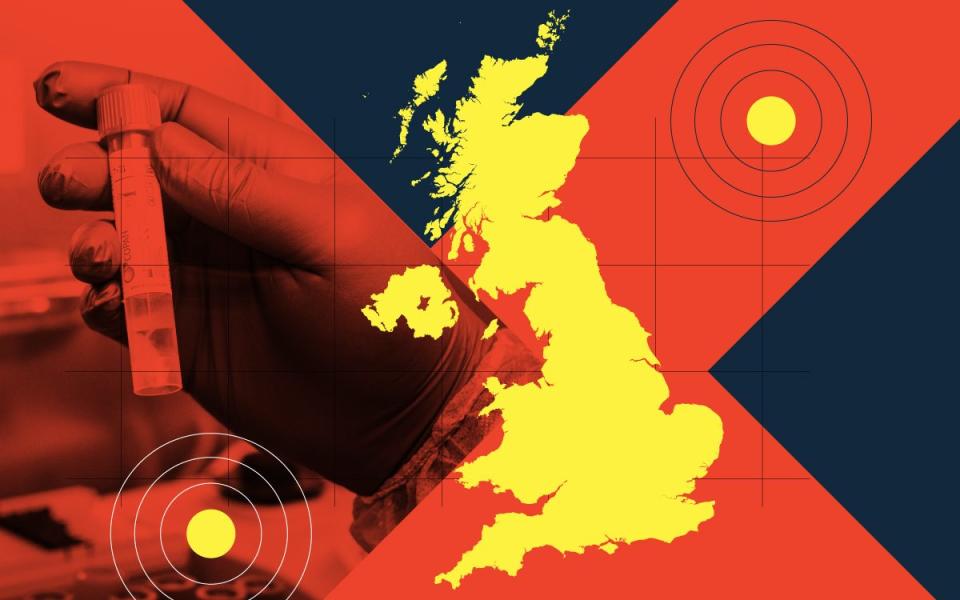Mapped: The hotspots for the Indian variant of Covid-19 in the UK

More than five million people in the UK now live in an area where the Indian variant may be the most common strain of Covid-19, data suggest.
More than half of coronavirus cases sequenced in the last fortnight in English local authorities with a combined population of 5.2m have been flagged as being the Indian variant of concern, according to figures published by the Wellcome Sanger Institute and Public Health England.
Data shows prevalence of the variant is highest in the North West of England in Bolton and Blackburn with Darwen - two local authorities that have seen extra vaccinations deployed in an attempt to protect residents against the Indian variant’s tightening grip on their local areas.
Lab results in the two weeks up to May 8 suggest that more than 80 per cent of cases from the community in these areas were the Indian variant - up from 28.6 per cent on April 24 in Bolton and 18 per cent in Blackburn with Darwen.
Bedford in the East of England and Sefton in Merseyside have emerged as two further hotspots for the strain, with the local authorities seeing more than 80 per cent of cases being detected as the Indian variant up to May 8.
Likewise Hart, Oadby and Wigston, South Northamptonshire and Stevenage have all seen at least 75 per cent of cases detected as the variant in the same period.
At a Downing Street coronavirus briefing on Friday, Boris Johnson said there are "important unknowns" about the Indian variant, including the extent to which it is more transmissible than previous strains, that could in turn mean delaying the final stage of lifting lockdown in England.
However the Prime Minister stressed there is no evidence that the vaccines will be less effective, saying: "We are in a different position from the last time we faced a new variant, before Christmas."
The Government is now accelerating second doses for the over 50s and those at risk to just eight weeks, and will be sending additional vaccines to the areas seeing clusters of the Indian variant.
Across England as a whole the variant has surged from two to 20 per cent cases in less than a month, fuelling concerns it will take the place of the so-called Kent variant as the dominant strain.
Random sampling of positive tests in the community analysed by the Wellcome Sanger Institute show that across England 19.6 per cent of cases in the two weeks up to May 8 were detected as the Indian variant, or B.1.617.2 as it is known scientifically.
That is compared to 7.3 per cent in the two weeks up to May 1 and 2.4 per cent up to April 24.
Other imported variants of concern - notably the South African and Brazilian variants - were detected earlier, but have not gained as strong a foothold as the Indian strain. Initial studies suggest it could be more contagious than them and also than B.1.1.7.
In just 40 days, the number of Indian cases had eclipsed the total number of South African cases seen in the 150 days since that was first detected.
That higher ability to spread may be driving the current surge in Covid cases in Bolton and Blackburn, which have both seen outbreaks of the variant.
Surge-testing is ongoing in Bolton, while Blackburn has seen surge vaccination, in which as many people are vaccinated as soon as possible, though so far there is not enough evidence to say decisively that the vaccine will be as effective against the variant.
However, in Blackburn and Bolton, case rates are on average three times higher in those areas with lower vaccine uptake.
In areas where more than 85 per cent of over-40s have received at least one dose, case rates average out at 89 cases per 100,000. This jumps to 261 cases per 100,000 in those areas where lower shares of over-40s have been vaccinated.
This does not necessarily mean the vaccine is stopping the spread.
Wards with high infection rates are generally in more deprived areas often associated with more cramped living conditions, people in public-facing jobs and individuals with underlying health conditions. These conditions, regardless of the variant, allow the virus to thrive.
Public health experts are now closely watching hospital data in the area, as well as transmission among older people in the areas.
Underpinning their concern is the alarming rate at which the variant is spreading, not unlike the Kent-variant which led to the peak of the second wave in January.
Currently, most of the cases being tracked are still being linked to international travellers and their contacts in the UK, but day-by-day the proportion of cases which are being traced to community transmission is increasing.
Recent figures from Public Health England suggest that the majority of these cases have come directly from India.
Around 90 confirmed cases arrived before India was added to the “red list” for international travel on April 24.
At the time, the Government was criticised for acting too slowly on closing the border.

 Yahoo Movies
Yahoo Movies 